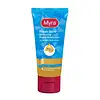What's inside
What's inside
 Key Ingredients
Key Ingredients

 Benefits
Benefits

 Concerns
Concerns

 Ingredients Side-by-side
Ingredients Side-by-side

Water
Skin ConditioningC12-15 Alkyl Benzoate
AntimicrobialCetyl Palmitate
EmollientCetyl Alcohol
EmollientSteareth-21
CleansingCyclopentasiloxane
EmollientNiacinamide
SmoothingGlycerin
HumectantEthylhexyl Methoxycinnamate
UV AbsorberTitanium Dioxide
Cosmetic ColorantPhenoxyethanol
PreservativeCI 16035
Cosmetic ColorantDimethicone
EmollientAcrylates/C10-30 Alkyl Acrylate Crosspolymer
Emulsion StabilisingDimethicone/Vinyl Dimethicone Crosspolymer
Skin ConditioningParfum
MaskingEthylhexylglycerin
Skin ConditioningDisodium EDTA
Sodium Hydroxide
BufferingSodium Starch Octenylsuccinate
AbsorbentCalcium Pantothenate
Maltodextrin
AbsorbentSodium Ascorbyl Phosphate
AntioxidantTocopheryl Acetate
AntioxidantPyridoxine Hcl
Skin ConditioningRumex Occidentalis Extract
Skin ConditioningAscorbic Acid
AntioxidantSilica
AbrasiveWater, C12-15 Alkyl Benzoate, Cetyl Palmitate, Cetyl Alcohol, Steareth-21, Cyclopentasiloxane, Niacinamide, Glycerin, Ethylhexyl Methoxycinnamate, Titanium Dioxide, Phenoxyethanol, CI 16035, Dimethicone, Acrylates/C10-30 Alkyl Acrylate Crosspolymer, Dimethicone/Vinyl Dimethicone Crosspolymer, Parfum, Ethylhexylglycerin, Disodium EDTA, Sodium Hydroxide, Sodium Starch Octenylsuccinate, Calcium Pantothenate, Maltodextrin, Sodium Ascorbyl Phosphate, Tocopheryl Acetate, Pyridoxine Hcl, Rumex Occidentalis Extract, Ascorbic Acid, Silica
Aloe Barbadensis Leaf Juice
Skin ConditioningCarbomer
Emulsion StabilisingSnail Secretion Filtrate
Skin ConditioningPEG-60 Hydrogenated Castor Oil
EmulsifyingTriethanolamine
BufferingMethylpropanediol
SolventCollagen
MoisturisingArbutin
AntioxidantPhenoxyethanol
PreservativeDipropylene Glycol
HumectantSodium Hyaluronate
HumectantGlycerin
HumectantDisodium EDTA
Allantoin
Skin ConditioningChlorphenesin
AntimicrobialParfum
MaskingCentella Asiatica Extract
CleansingPortulaca Oleracea Extract
Skin ConditioningAloe Barbadensis Leaf Juice, Carbomer, Snail Secretion Filtrate, PEG-60 Hydrogenated Castor Oil, Triethanolamine, Methylpropanediol, Collagen, Arbutin, Phenoxyethanol, Dipropylene Glycol, Sodium Hyaluronate, Glycerin, Disodium EDTA, Allantoin, Chlorphenesin, Parfum, Centella Asiatica Extract, Portulaca Oleracea Extract
 Reviews
Reviews

Ingredients Explained
These ingredients are found in both products.
Ingredients higher up in an ingredient list are typically present in a larger amount.
Disodium EDTA plays a role in making products more stable by aiding other preservatives.
It is a chelating agent, meaning it neutralizes metal ions that may be found in a product.
Disodium EDTA is a salt of edetic acid and is found to be safe in cosmetic ingredients.
Learn more about Disodium EDTAGlycerin is already naturally found in your skin. It helps moisturize and protect your skin.
A study from 2016 found glycerin to be more effective as a humectant than AHAs and hyaluronic acid.
As a humectant, it helps the skin stay hydrated by pulling moisture to your skin. The low molecular weight of glycerin allows it to pull moisture into the deeper layers of your skin.
Hydrated skin improves your skin barrier; Your skin barrier helps protect against irritants and bacteria.
Glycerin has also been found to have antimicrobial and antiviral properties. Due to these properties, glycerin is often used in wound and burn treatments.
In cosmetics, glycerin is usually derived from plants such as soybean or palm. However, it can also be sourced from animals, such as tallow or animal fat.
This ingredient is organic, colorless, odorless, and non-toxic.
Glycerin is the name for this ingredient in American English. British English uses Glycerol/Glycerine.
Learn more about GlycerinParfum is a catch-all term for an ingredient or more that is used to give a scent to products.
Also called "fragrance", this ingredient can be a blend of hundreds of chemicals or plant oils. This means every product with "fragrance" or "parfum" in the ingredients list is a different mixture.
For instance, Habanolide is a proprietary trade name for a specific aroma chemical. When used as a fragrance ingredient in cosmetics, most aroma chemicals fall under the broad labeling category of “FRAGRANCE” or “PARFUM” according to EU and US regulations.
The term 'parfum' or 'fragrance' is not regulated in many countries. In many cases, it is up to the brand to define this term.
For instance, many brands choose to label themselves as "fragrance-free" because they are not using synthetic fragrances. However, their products may still contain ingredients such as essential oils that are considered a fragrance by INCI standards.
One example is Calendula flower extract. Calendula is an essential oil that still imparts a scent or 'fragrance'.
Depending on the blend, the ingredients in the mixture can cause allergies and sensitivities on the skin. Some ingredients that are known EU allergens include linalool and citronellol.
Parfum can also be used to mask or cover an unpleasant scent.
The bottom line is: not all fragrances/parfum/ingredients are created equally. If you are worried about fragrances, we recommend taking a closer look at an ingredient. And of course, we always recommend speaking with a professional.
Learn more about ParfumPhenoxyethanol is a preservative that has germicide, antimicrobial, and aromatic properties. Studies show that phenoxyethanol can prevent microbial growth. By itself, it has a scent that is similar to that of a rose.
It's often used in formulations along with Caprylyl Glycol to preserve the shelf life of products.